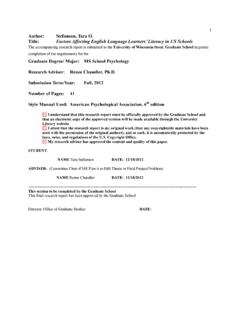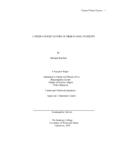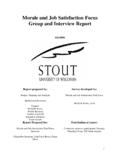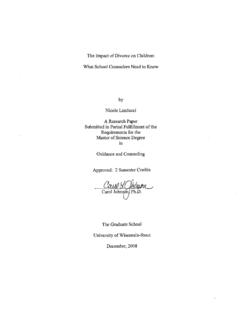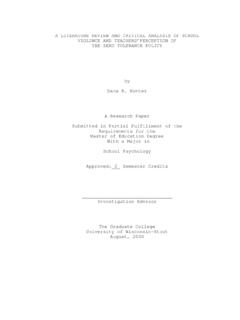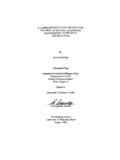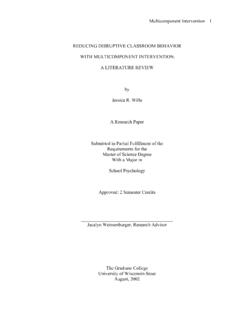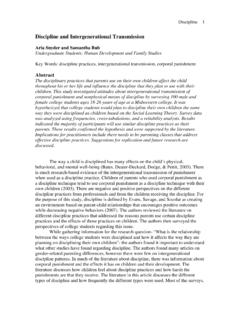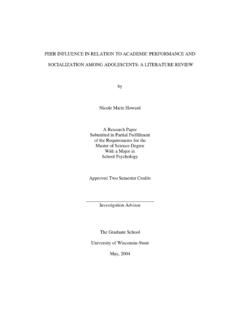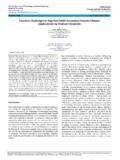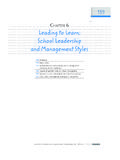Transcription of UNDERSTANDING AT-RISK YOUTH AND …
1 UNDERSTANDING AT-RISK YOUTH AND INTERVENTION PROGRAMS THAT HELP THEM SUCCEED IN SCHOOL By Janis Kay Dobizl A Research Paper Submitted in Partial Fulfillment of the Requirements for the Masters of Science Degree With a Major in Guidance and Counseling Approved: 2 Semester Credits _____ Investigation Advisor The Graduate School University of Wisconsin Stout July, 2002 The Graduate School University of Wisconsin Stout Menomonie, Wisconsin 54751 i ABSTRACT (Last Name) (First) (Initial) UNDERSTANDING AT-RISK YOUTH and Intervention Programs That Help Them_____ (Title) Succeed In School_____ _____ Guidance and Counseling__ _ Dr.
2 Denise Zirkle_____ July, 2002_ ___ (Graduate Major) (Research Advisor) (Month/Year) _____American Psychological Association (APA) Publication Manual_____ (Name of Style Manual Used in this Study) The purpose of this literary review was to research AT-RISK YOUTH to gain a better UNDERSTANDING of the difficulties and challenges that co-exist with this problem, particularly the increasing numbers of high school dropouts that has reached crisis proportions. The situation requires serious work be done to help combat the dropout problem. The literary review explored and defined what AT-RISK really means, what impact this problem has on society, the misconceptions associated with the term AT-RISK , and school-wide intervention programs designed to reach students AT-RISK and promote school success.
3 This literary review also addressed the methods schools use to identify students AT-RISK , strategies to enhance student s learning experiences at school, and other methods to challenge AT-RISK students to stay in school. Making a positive difference in a student s educational experience can be accomplished by helping them feel as though they belong (Sanders and Sanders, 1998). Effective intervention programs require the collaborative efforts and talents of students, ii educators, parents, community members, and business leaders coming together to address and meet the needs of their YOUTH AT-RISK . The assumption that YOUTH AT-RISK are incapable of learning and/or do not care about anything is a fallacy.
4 The truth of the matter is our YOUTH do care and they want and can learn. They long for adults who are willing to make the effort to understand them and who will provide them the acceptance and guidance they need. If one is patient and looks hard and deep enough, they will understand that the AT-RISK child s message is this - Don t give up on me. iii Acknowledgment I have been given the greatest gift of all from my husband, Howie, and children, Jolene and Ken. Throughout the many years it has taken me to accomplish my goal from earning an Associate s Degree to a Bachelor s Degree and to, finally, receiving my Master s Degree in Guidance and Counseling, they have offered me nothing less than their love, support, and encouragement.
5 And for this I shall forever be grateful to them. I also want to thank my other family members and friends who have stuck by my side and supported me in my quest to further my education. And to Dr. Denise Zirkle who has been an absolute delight to have both as my professor in class, and as my advisor on this project. Dr. Zirkle s continuous interest and availability propelled me to progress through this undertaking. Without her I would not have made the progress I did. I am very thankful to Dr. Zirkle for her insight and expertise in the field of education and her willingness to work with me to the end. Thank you all. iv TABLE OF CONTENTS Table of CHAPTER ONE Introduction.
6 1 Statement of the Problem ..4 Definition of CHAPTER TWO Literature The YOUTH We Label Identifying AT-RISK Resilience in Other Factors Attributing to School UNDERSTANDING Children AT-RISK : do we need an attitude adjustment?..12 AT-RISK YOUTH : A National Systems Change: Family, School, and Preliminaries to Intervention Identifying Students Examples of School-Wide Intervention CHAPTER THREE Analysis of Literature ..36 CHAPTER FOUR Summary and Recommendations ..45 1 CHAPTER ONE Introduction Don t give up on me. It is unlikely we will hear these exact words from our troubled YOUTH . In fact, the words they speak and the behaviors they exhibit are paradoxical, cunningly leading us to believe that they don t care about anything.
7 But the truth of the matter is, our YOUTH do care. They not only need caring and concerned adults in their lives, but also long for adults who willingly make the effort to understand them and who believe in them. And, they do want to learn, contrary to what many people believe. According to Conrath (1994), this is the central, however covert, message our troubled YOUTH are sending adults. The primary objective is to help kids build their self-esteem, self-confidences, and an internal sense of responsibility. He tells those individuals when working with troubled youths to always remember the most important work in the world is going on: learning; gaining self-reliance; participating in the culture (Conrath, 1994, p.)
8 44). The fruits of our labors may not always be immediate. In fact, according to research, it oftentimes takes years before we see the desired changes in the behaviors and attitudes of our more challenging YOUTH (Blankstein, 1997). The problem isn t going to disappear any time soon. There is no doubt challenges are a mainstay in our schools. Its customers, our YOUTH , inherently generate insignificant uprisings regularly and will continue to do so while schools are in existence. But there is a deeper, more profound issue lurking within our schools. Shadowing the so-called well-adjusted student, are the YOUTH falling victim to an extensive range of risk factors that make them a member of a growing population of diverse youths labeled AT-RISK .
9 Those risk factors, described Morris (2000, p. 4) are 2 low achievement, retention in grade, behavior problems, poor attendance, low socioeconomic status, and attendance at schools with large numbers of poor students. YOUTH who have been afflicted with many risk factors will drop out earlier than others (Kronick, 1997). McMillian and Reed (1994) however, have a different perspective on students AT-RISK . For some students AT-RISK , it has been their exposure to these same risk factors that helped in their developing the necessary coping skills enabling them to triumph over their adversities. These resilient undercover YOUTH are truly survivors in the system.
10 The trouble associating academic success with the symptoms of AT-RISK is that it seldom, if ever, co-exists. Even though not all students AT-RISK perform inadequately academically, most do, and it begins early in their school experiences (Lundenberg, 1999, ). In such cases, one will triumph over the other, academic success usually suffering defeat. School intervention programs should be in place for the rebound if they are to keep their students in school. But what will it take? Roderick said: Reducing dropout rates also requires that we have a base of knowledge of the manner in which a YOUTH s school experiences and the institutional characteristics of the school he or she attends influences the course of his or her school career (1993, ).
